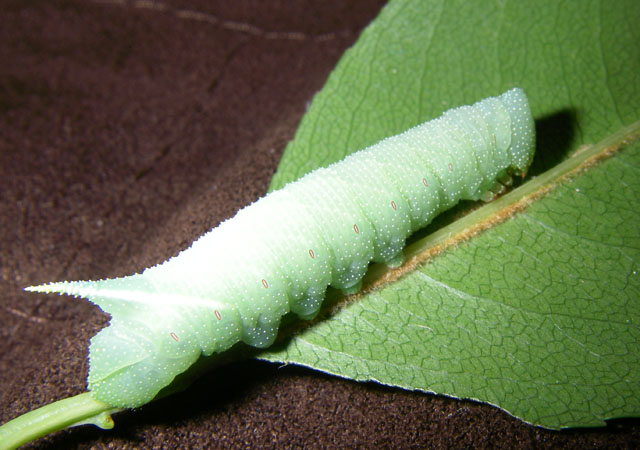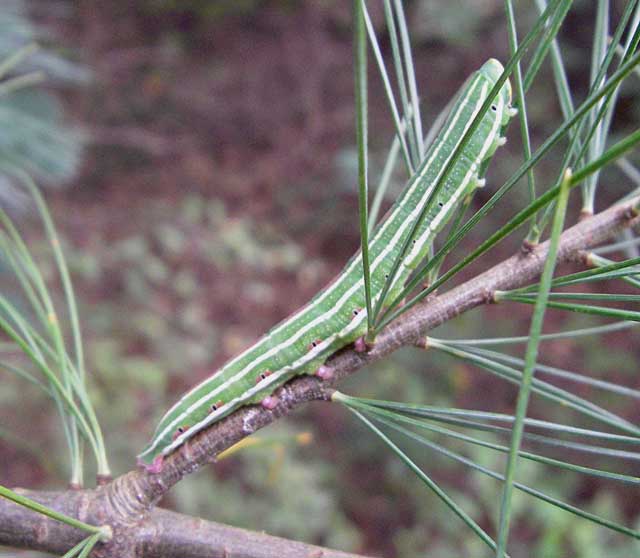Washingon County, Rhode Island
Sphingidae Larvae
Paonias excaecata, Washington County, coourtesy of Ryan Saint Laurent.
|
|
Updated as per James P. Tuttle's The Hawk Moths of North America, July 2008 Updated as per personal communication with Ryan Saint Laurent, (Ceratomia amyntor larva on birch), August 27, 2009 Updated as per personal communication with Ryan Saint Laurent, (Darapsa choerilus larva on Viburnum; Hyles lineata larva), September 10, 2009 Updated as per personal communication with Ryan Saint Laurent, (Lapara bombycoides larva on Pinus strobus); September 13, 2010 |

Paonias excaecata, Washington County, coourtesy of Ryan Saint Laurent.
Ryan has also reported finds of Hemaris thysbe larvae and an adult Deidamia inscriptum June 1, 2008.
Ryan writes, "Today (June 1st) I found a female (pretty sure it was female) lettered sphinx adult resting on tall grass not far from my house. May have recently eclosed because of its good condition. I brought it home and photographed it, then sat it on a tree. There is a lot of grape around my house so maybe I'll come across some larvae later this year. I'll go back out tonight probably to see if there is a male. This would be my first sphinx of the year, and my first Lettered Sphinx in Washington County, RI."
In August of 2009, Ryan sent a beautiful image of a Ceratomia amyntor larva that he found feeding on birch. Click on the link below the amyntor thumbnail.
Ryan confirms Darapsa choerilus (image and data via link below) and Hyles lineata.
Eleven Sphingidae species are listed for Rhode Island on the U.S.G.S. website. Not all of the species are reported or anticipated in Washington County (eight are reported on U.S.G.S.: Northern pine sphinx (Lapara bombycoides), Southern pine sphinx (Lapara coniferarum), Blinded sphinx (Paonias excaecata), Wild cherry sphinx (Sphinx drupiferarum), Apple sphinx (Sphinx gordius), Poecila sphinx (Sphinx poecila), Achemon sphinx (Eumorpha achemon) and Pandorus sphinx (Eumorpha pandorus).
I have added many species to the list which I feel are likely present.
It is hoped that this checklist, with the thumbnails and notes, will help you quickly identify the moths you are likely to encounter.
A "WO" after the species name indicates that I have no confirmed reports of this species in your county, but I (William Oehlke) expect that this moth is present or or might be present. I have added many species.
A USGS indicates the moth is reported in the USGS and/or in Lepidoptera of North America, #1. Distribution of Silkmoths (Saturniidae) and Hawkmoths (Sphingidae) of Eastern North America, an excellent little booklet available through Paul Opler.
Please help me develop this list with improved, documented accuracy by sending sightings (species, date, location), preferably with an electronic image, via email to Bill Oehlke.
Visit Sphingidae of the Americas to access similar Sphingidae lists for all US states and counties, all Canadian provinces, Mexico, all Central and South American countries.
Visit North American Catocala to access pictoral checklists for Catocala (underwing moths) for all US states and all Canadian provinces.

Lapara bombycoides fifth instar, Washington County, Rhode Island,
on Pinus strobus, September 12, 2010, courtesy of Ryan St. Laurent.
Sphinginae subfamily
Smerinthini Tribe:
Macroglossinae subfamilyDilophonotini tribe:
See Hemaris comparison to help distinguish the next three species.
Philampelini tribe:
Macroglossini tribe:
|
Enjoy some of nature's wonderments, giant silk moth cocoons. These cocoons are for sale winter and fall. Beautiful Saturniidae moths will emerge the following spring and summer. Read Actias luna rearing article. Additional online help available.
Eggs of many North American species are offered during the spring and summer. Occasionally summer Actias luna and summer Antheraea polyphemus cocoons are available. Shipping to US destinations is done from with in the US.
Use your browser "Back" button to return to the previous page.
This page is brought to you by Bill Oehlke and the WLSS. Pages are on space rented from Bizland. If you would like to become a "Patron of the Sphingidae Site", contact Bill.
Please send sightings/images to Bill. I will do my best to respond to requests for identification help.
 Show appreciation for this site by clicking on flashing butterfly to the left. The link will take you to a page with links to many insect sites. |